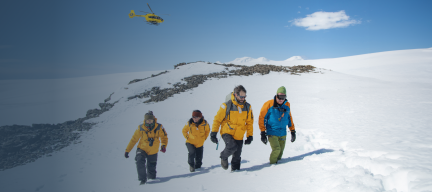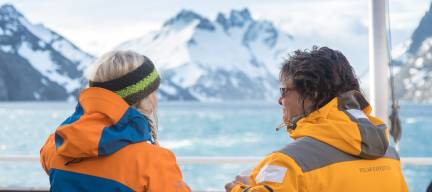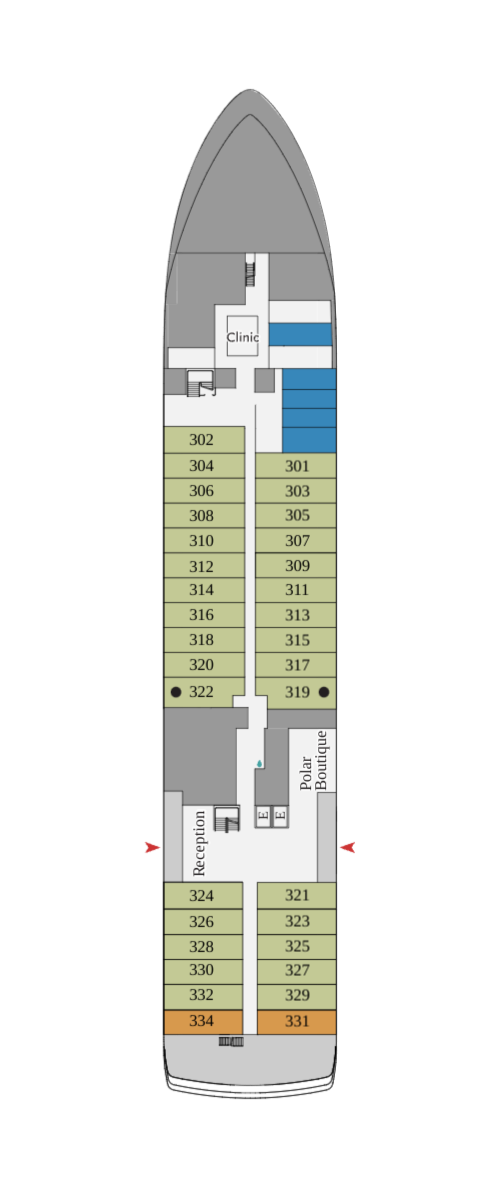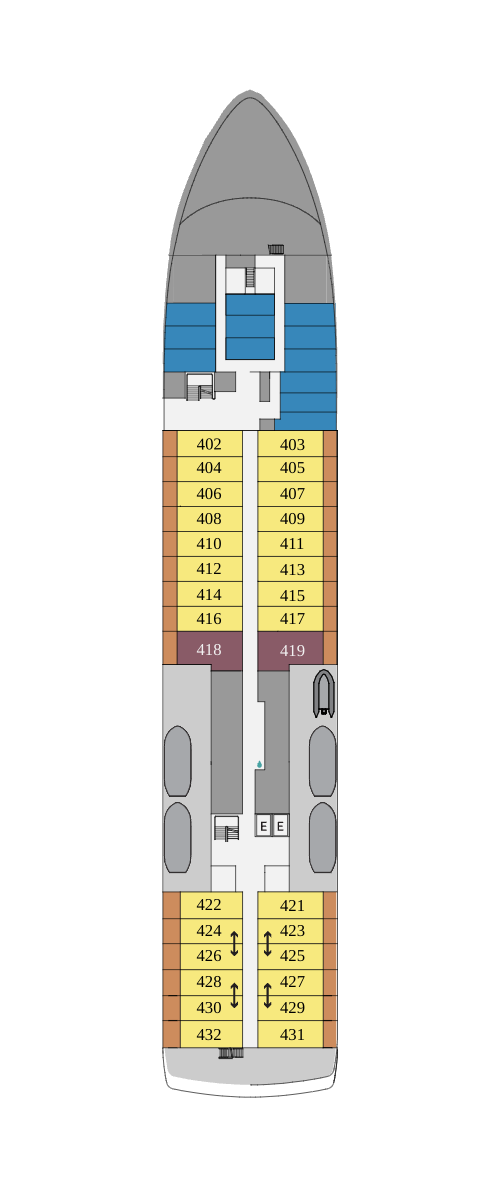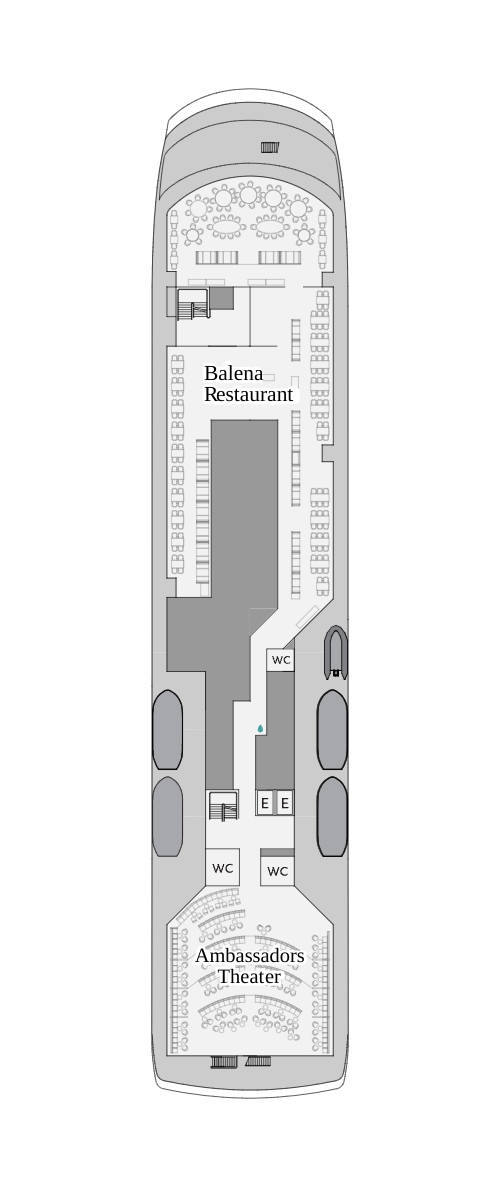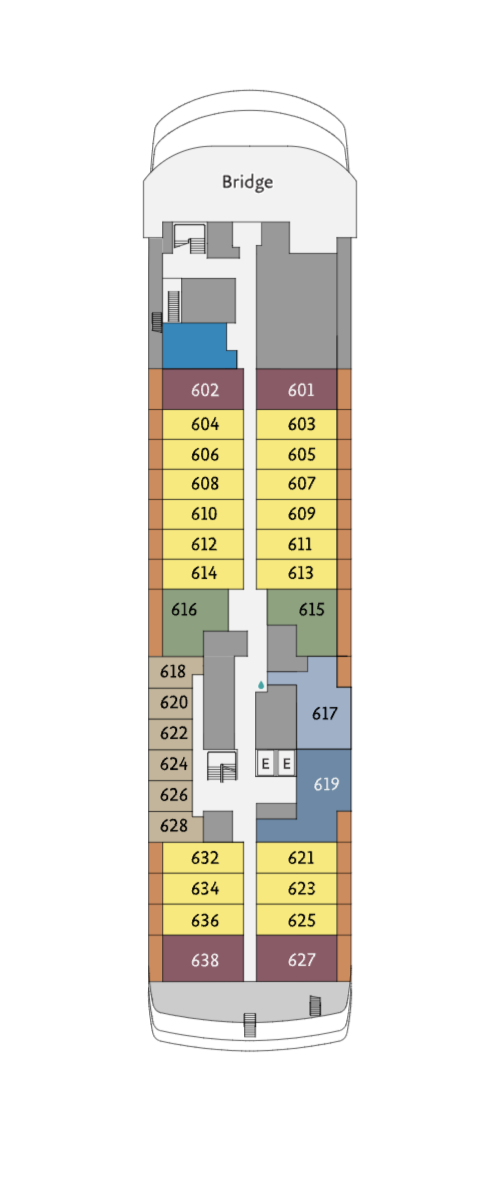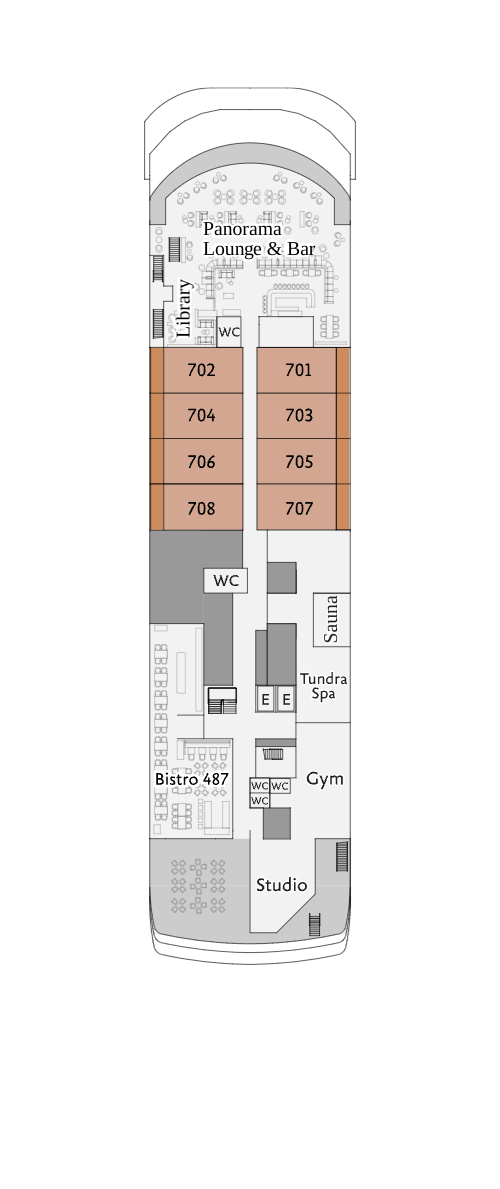Essential Patagonia Chilean Fjords and Torres del Paine
Starting from
- Buenos Aires, Argentina
Ships
- Ultramarine
Departures





















Expedition Overview
The size and geography of Chilean Patagonia, the vast stretch at the southern tip of South America marked by towering peaks, glacial fjords and temperate rainforest, can be challenging to land-based exploration. Luckily, the innovative Quark Expeditions team has surmounted this challenge by creating a ship-based itinerary— with the support of two twin-engine helicopters—that enables guests to maximize their Patagonian adventure in ways no other operator can. Guests can experience the fascinating diversity of Patagonia—including its wildlife—and return at the end of each day to their comfortable suite aboard Ultramarine and all of its amenities.
Retrace Charles Darwin’s epic voyage to the ‘edge of the world’ on our 15-day Essential Patagonia: Chilean Fjords and Torres del Paine expedition, a comprehensive journey into Chile’s spectacular network of fjords and channels. Helicopter flightseeing and Zodiac cruises along this enchanting stretch of coastline provide awe-inspiring perspectives of some of the most remote and picturesque landscapes on Earth. From llama-like guanacos, Magellanic penguin colonies and other seabirds to South American sea lions and southern elephant seals, the wildlife of this region is as abundant as the majestic blue-toned tidewater glaciers. Join us in this enchanting
wonderland and experience all the natural splendors of southern Patagonia.
Our technologically-advanced ship Ultramarine is designed to extend the boundaries of exploration and offer an unmatched experience, including a flightseeing tour you’ll never forget! Our team of Polar Travel Advisers are happy to answer your questions at any time. Come and explore Patagonia by ship. You’ll see more, explore more, and conquer more!
Highlights
Encounter iconic wildlife, such as Magellanic penguins, sea lions and seabirds
Experience some of the world’s most remote glacial and fjord systems, including Glacier Alley
Retrace Darwin’s route through the Beagle Channel and learn about the storied history of southern Chile
Cruise in a Zodiac for a unique perspective of glaciers, fjords and channels
Enjoy helicopter flightseeing from Ultramarine for a unique perspective of the landscape
Find Your Ideal Itinerary
From Buenos Aires, Argentina, 15 days, on Ultramarine
- Duration
- 15 days
- Departing from
- Buenos Aires, Argentina
- Ship
-
Ultramarine
Learn more about the ship - Starting from
- $12,449 USD per person

From Buenos Aires, Argentina, 15 days, on Ultramarine
- Duration
- 15 days
- Departing from
- Buenos Aires, Argentina
- Ship
-
Ultramarine
Learn more about the ship - Starting from
- $12,321 USD per person

Ultramarine
Ship Amenities
- Ready Rooms
- Polar Boutique
- Ambassador Theater
- Balena Restaurant
- Bridge
- Bistro 487
- Tundra Spa
- Tundra Sauna
- Fitness Center
- Panorama Lounge and Bar
Ship Features
- 40-day Operational Range
- Four Embarkation Points
- MAGS
- Twin Engine Helicopters
- Water-level Zodiac Hangar
- Wraparound Deck

Ultramarine

Ultramarine Helicopter

Ultramarine Deck

Ultramarine

Ultramarine Balcony Suite (Double Bed)

Ultramarine Passengers

Ultramarine

Ambassadors Theater

Ultramarine Terrace Suite

Ultramarine Library

Ultramarine's Ready Room

Ultramarine Fitness Center

Ultramarine

Ultramarine Spa

Ultramarine Sauan

Andvord Bay
Your Life Onboard






Enjoy panoramic views while you mingle in our comfy lounges, or head outside and chat with fellow adventurers on the wraparound deck. Our social spaces foster connections & shared experiences.

Engage with world-class experts in our auditorium. Presentations cover wildlife, history, marine biology, ecology, & geology, to enhance your polar knowledge & excitement for exploration.

Enjoy onboard amenities, attend lectures, or watch for wildlife from our observation decks. Sea days offer a perfect blend of education, relaxation, and anticipation.

Find tranquility in our well-stocked library, perfect for reading or quiet contemplation. The glass-domed Observation Lounge offers a peaceful retreat to reflect & enjoy awe-inspiring polar views.

Prepare for off-ship excursions in our spacious mudroom. Kayak, paddleboard, or take a plunge in polar waters. Stay active onboard with our gym, outdoor track, and pool facilities.

What’s Included
Specialist Expedition Leaders
Our team is comprised of the most professional and passionate Expedition Leaders in the world, who bring a wide range of experience and expertise to every adventure.
Immersive Off-ship Activities
Itineraries are packed with adventure options designed to immerses travelers in the polar wilderness, enabling them to connect with the natural wonders of their surroundings.
On-Ship Experiences & Facilities
Designed for comfort and adventure, each ship accommodates no more than 200 guests. Facilities include comfortable cabins, exceptional dining options, wellness treatments, and breathtaking panoramic views of the polar landscape.
Food & Beverages
Premium dining, with a wide selection of options that accommodate a variety of dietary preferences.
Quark Expedition Perks
Complementary Wi-Fi, alcohol on all voyages, and the Official Quark Expeditions parka to take home.
Transfers
Select voyages include essential transportation and accommodation arrangements for guests, ensuring seamless travel to and from the expedition starting point.
International airfare & visa expenses, travel insurance, mandatory expedition gear, on-ship expenses, adventure options and trip extensions are not included.
Included Activities

Flightseeing in the Antarctic, Aboard Ultramarine

Hiking in the Antarctic

Polar Plunge in the Antarctic

Zodiac Cruising in Antarctic
Upgrade Your Expedition
Adventure Options
Trip Extensions

Buenos Aires, Argentina
Look no further than the pink-toned La Casa Rosada, the opulent presidential residence, to truly appreciate that cosmopolitan Buenos Aires is proud of its art and architecture. The metropolis attracts more tourists than any other city in South America. Visitors gravitate toward the city’s artful graffiti, alfresco dining, tango dancing, and the energy of the crowds in Playa de Mayo in the heart of the 400-year-old capital.

Easter Island, Chile
Easter Island (its Polynesian name is Rapa Nui) is a remote volcanic island in Polynesia that’s known for its nearly 900 monumental statues called moai, which date from the 13th to 16th centuries. Easter Island is one of the world’s most isolated inhabited islands. Despite being part of Chile, it’s more than 3,500 kilometers from the west coast of the South American continent. Easter Island was designated a UNESCO World Heritage Site in1966.

Iguazú Falls, Argentina
Iguazú Falls is a three-kilometer stretch of massive waterfalls on the Iguazú River on the border between Argentina and Brazil. The falls, 80% of which are on the Argentine side of the river, are the largest waterfall system in the world. There are 275 individual waterfalls, some of which reach 269 feet high (82 metres). The falls actually lie within Iguazú National Park, which is a UNESCO World Heritage Site. The falls were named one of the Seven Wonders of Nature in 2011.

Santiago, Chile
It’s a city blessed by nature, yet cosmopolitan at the same time. The Chilean capital of Santiago (population 6.5 million) sits in a valley surrounded by the snow-covered peaks of the Andes and the Chilean Coast Range. Visitors have their pick of sidewalk eateries, cafes and beer halls, hillside parks, grand architecture, museums, pedestrian malls, and tony restaurants of chic neighborhoods like Providencia and Las Condes, and colorful barrios like Brasil, Lastarria and Bellavista.
Possible Excursions
This striking blue glacier, which flows down from the middle of the Darwin mountain range, sits at the end of a tranquil lagoon formed by the glacier’s meltwater. An easy hike along the shore takes you to the edge of the glacier.
Ainsworth BayAn offshoot of Almirantazgo Sound (Admiralty Sound), Ainsworth Bay is surrounded by pristine sub-polar forests. The bay is fed by the meltwater of the Marinelli Glacier, which flows down from the Cordillera Darwin Icefield.
Bahia BrookesLocated in Almirantazgo Sound (Admiralty Sound), in the heart of Alberto de Agostini National Park, this bay is the site of several glaciers, the most impressive being the North Brookes Glacier. The bay is also an ideal locale for learning about the glaciology and how they shape the landscape.
Canal de las MontañasSituated within the Kawésqar National Park (formerly Alacalufes National Reserve), this 41-mile (66 km) long channel is flanked by two majestic mountain ranges, the Cordillera Riesco to the east and the Cordillera Sarmiento to the west. Sightings of sea lions and dolphins are possible.
Marta IslandMarta Island, along with nearby Magdalena Island, is a designated natural monument, Monumento Natural Los Pingüinos (The Penguins Natural Monument), and has been a protected area since 1982. The small island is home to a large colony of sea lions, as well as an abundance of seabirds, including cormorants, skuas and gulls.
Pia GlacierIn the Beagle Channel, Pia Glacier is situated in a fjord in the Cordillera Darwin (Darwin Mountains), the southern part of the Andes mountain range. This area provides outstanding opportunities for taking the Zodiacs out for a shore landing and hiking to a spectacular lookout. Though the provenance of the glacier’s name remains unconfirmed, some believe Alberto Maria de Agostini, an Italian missionary, mountaineer and explorer who lived in Tierra del Fuego, named it after Princess Maria Pia of Savoy, the daughter of Italy’s first king.
Tuckers IsletsLocated in Almirantazgo Sound (Admiralty Sound), a stunning offshoot of the Strait of Magellan, this tiny group of islands is covered in grasses, mosses and small trees, providing a verdant backdrop for viewing a large colony of nesting Magellanic penguins. Other bird species that may be spotted here include king and rock cormorants, oystercatchers, Chilean skuas, kelp geese and dolphin gulls.
Sitting at the southernmost tip of Tierra del Fuego, on Hornos Island, Cape Horn was named by Dutch navigator Willem Schouten, who discovered and first rounded the cape in 1616 and named it in honor of his birthplace, Hoorn, Holland. Filled with rugged, natural beauty, the historic windswept cape is located within Cabo de Hornos National Park, which was designated a UNESCO Biosphere Reserve in 2005. The Chilean Navy maintains a station on the island.
Diego Ramírez IslandsAbout 62 miles (100 km) southwest of Cape Horn, these little-known islands constitute the southernmost point of South America. They’re also the continent’s most southerly inhabited outpost, as the Chilean Navy maintains a weather station here that was established in 1951. The archipelago is an Important Bird Area, home to nesting albatross, as well as blue petrels, diving petrels and sooty shearwaters.
Departure Dates & Cabins
Know Before You Go
For your personal safety—and to ensure you get the most enjoyment out of your polar adventure—please assess your mobility and medical requirements before booking. It is essential that guests have a high level of mobility to get in and out of Zodiac boats, and for off-ship activities such as hiking on uneven terrain. Our destinations are remote. Apart from our basic ship infirmary, it could take up to 72 hours to reach adequate medical facilities. For more details to help you assess your mobility and medical requirements before booking your voyage, please review Health & Safety.
Some of our expeditions have included transfers and these will be detailed in your Invoice and Trip Brochure.
Please note that if you have an airport transfer included in your trip, it is only available if you arrive on Day 1 of the itinerary. Please ensure your flight information on your Passenger Forms is up to date so our ground crew know when to expect you. There will be someone with a sign in Arrivals waiting for you. Please look for them and they will direct you to our group shuttle.
If you do not have included transfers, or you are arriving before Day 1, you will need to make your own way to the hotel. Most airports we travel in and out of have good taxi ranks in the Arrivals area, or you can often prebook a transfer online.
Packing is an exciting part of the trip for many of us. You will find a handy packing list towards the end of your Trip Brochure. You will have received a copy of this when you first booked. We also have two excellent videos, which you can check out here: What to Pack
Our Protection Promise allows you to make a purchase decision that will leave you worry-free in the event your plans change down the road. Please review details for each term in our Quark Expeditions Protection Promise.
Whether you are thinking of an expedition, or you’ve booked the trip of a lifetime with Quark Expeditions, review all our FAQs for comprehensive tips to help you prepare for the Polar Regions and how to make the most out of your voyage with the most experienced expedition team in the industry. If your specific question isn’t covered below, please reach out to your Polar Travel Advisor or helpful Client Experience Team at guest@quarkexpeditions.com.






